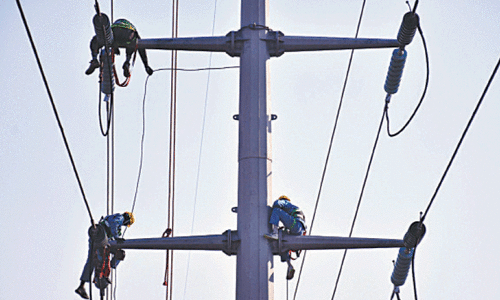
UNABATED intrusion of the Arabian Sea into the coastal districts of Badin and Thatta continues to destroy farmlands, fishing areas and ancestral coastal villages.
Due to climate change and inadequate Indus water flows in downstream Kotri, the dwellers there are struggling to eke out a living and the going is getting tougher for them with each passing day. They are losing fish catch and experiencing food insecurity.
Having realised the gravity of the situation, the federal Ministry of Science and Technology has formed a Working Group on Sea Water Intrusion and Land Subsidence, which is headed by the National Institute of Oceanography (NIO). Its members are Suparco, Pakistan Navy, Pakistan Meteorological Department and the Sindh University’s Coastal Zone Department. Its four-member observation team, along with a Chinese expert, have visited the coastal areas of Sindh.
The working group has been tasked by the government to assess the severity of the situation and find areas that are particularly vulnerable to sea intrusion
All member-departments of the working group are currently busy collecting relevant data. Pakistan Navy is examining old maps of the area while Suparco is going through its satellite imagery and the NIO is analysing its own present and past data.
NIO Director General Asif Inam says verified and reliable data as to how much water from the Arabian Sea is reaching downstream Kotri is not available, as it is hard to assess the available data.
“We are not relying solely on data from the irrigation department or the recording station at Kotri Barrage, but are also collecting data on our own so that we have verifiable statistics,” he says.
The working group has been tasked by the government to assess the severity of the situation and find areas that are particularly vulnerable to sea intrusion. It will then suggest mitigation measures to the government for necessary action.
The group’s findings will focus on the actual loss of agricultural land to the sea ever since water flows in the Indus declined owing to diversion of the river water through storages and canals, as well as those precipitated by the 1960 Indus Water Treaty.
Board of Revenue Secretary Munawar Mahesar confirms that since 1980, around 3.5m acres of farmland has been lost in just two coastal districts of Badin and Thatta. “No latest information after the 1980s is available,” he says.
However, the downstream releases of irrigation water are considered wastage of freshwater by those advocating for building dams like Kalabagh. About 350,000 acres of the command area of the Pinyari Canal, an off-taking canal of the Kotri Barrage, became saline and waterlogged 15 years ago owing to seawater intrusion, says veteran farmer Abdul Majeed Nizamani. This land touches the eastern part of the Indus delta.
Sea intrusion and land erosion are forcing local communities to resettle in lands that are waterlogged and saline, where they are unable to even grow vegetables. “Many are being exploited by middlemen who buy their catch at low prices, with some forced to borrow money from them for their survival,” says a Pakistan Fisherfolk Forum activist from Thatta, Gulab Shah.
DG Asif Inam points out that as the Indus delta is quite flat, this makes it more vulnerable to sea intrusion. “The sea level is rising by 1.3mm per annum. The delta has a muddy topography so its sinking a little easy.”
The Indus delta, said to be the world’s seventh largest, used to be rich in resources. Different species of animals and fish, as well as honey, orchards and pastures were in abundance; these are now becoming extinct. Drinking water is a precious commodity and the residents have to buy it from in areas like Kharochaan, Shah Bundar and Keti Bundar.
Mangroves were reduced from 260,000 hectares in the 1970s to 160,000 hectares by the early 1990s, while latest studies put the figure at 80,000 hectares. This has badly impacted fish and prawn production as well as other aquatic life.
Currently, the International Union for Conservation of Nature (IUCN) is collaborating with the Sindh forest department for planting mangroves on 50,000 hectares under a seven-year project in Thatta.
This is expected to substantially improve the production of crabs, prawn and 25 other species of fish that have higher commercial export value. Presently, four species of salt-tolerant mangroves are surviving in the deltaic region.
The ICUN’s Tahir Qureshi says the plantation of trees will lessen the impact of cyclones as well. This is the natural way to control sea intrusion. Mangroves — which absorb 70-90pc of a cyclone wave’s energy — are being planted in Keti Bunder, Shah Bundar and Kharo Chhan, the worst affected areas in Thatta district.
The project, in its second year, is due to be completed by 2018-19. Qureshi believes that once the catch and production of other fish is improved, the migrating community would be encouraged to stay and resettle there.
Published in Dawn, Business & Finance weekly, December 28th, 2015













































